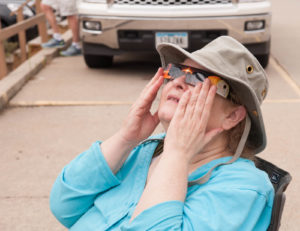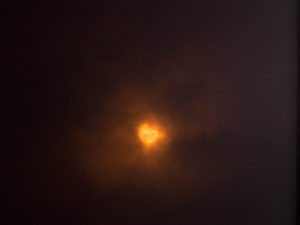We drove down into Iowa Sunday, to put us in striking range of a variety of viewing sites in the totality zone on Monday.
Even Sunday, we encountered traffic and crowding on Interstate 35; we had to wait for a table at a Culver’s down in Iowa. We did seem to be a bit ahead of the crowd, since our hotel’s parking lot was nearly empty when we got there (or maybe the people on I35 had planned ahead further than us and had hotels down in the totality zone).
Weather forecasts looked fairly dismal. We poked at them a lot, and on Monday morning we chose Falls City Nebraska as our viewing site.
 The route there was all back roads, and we encountered no particular traffic. However, the town was quite active, with clear eclipse events at various places, and many optimists hoping to sell $20 parking. We ended up in the parking lot of an empty fast food facility, with a good view of the clouds overhead. A number of other group showed up there shortly.
The route there was all back roads, and we encountered no particular traffic. However, the town was quite active, with clear eclipse events at various places, and many optimists hoping to sell $20 parking. We ended up in the parking lot of an empty fast food facility, with a good view of the clouds overhead. A number of other group showed up there shortly.

There were thinner spots in the clouds, and occasionally you could tell where the sun was; or even see the disk (filtered by the clouds; at this stage, with the eclipse protective glasses you could see nothing at all, you couldn’t even tell where the sun was behind the clouds).
This raised a technical point I hadn’t really planned for. With the eclipse glasses, or the solar filter over the lens on the camera, you could see nothing at all. Sometimes the clouds were heavy enough we couldn’t tell where the sun was, but when they thinned and you got hints of the sun, sometimes a view of the full disk, you still couldn’t see anything through the filters. This made it difficult to get the camera trained and ready to capture anything that might briefly show through the clouds. It also left me bouncing back and forth between filters and no filters, trying not to expose my eyes or even the camera sensors to the bare sun, but needing to use bare eyes and sensors to find it much of the time. (There don’t appear to be any weird blind spots in my eyes today, I seem to have been careful enough or lucky enough.)

The clouds thinned out a few times, and we got views near first contact, and occasional views thereafter.
We got some very heavy-duty insectile assistance while waiting for the eclipse to start. Looks like a very big wasp, and we saw it entering and leaving a crack in the pavement, so I guess ground-dwelling. Carrying something even bigger than it was; food for itself or for the next generation I guess.
The light seemed to dim in definite steps as we neared totality, not continuously. It was a weird effect, and repeated a number of times. People watching seemed to agree on when a step had happened.
It did get very dark. We had something like a sunset (except that the sun wasn’t there) all around the horizon; it was dark overhead, but light on all sides, with the sun out there clearly lighting up the clouds. Not sure one would see this effect without the clouds; though just the diffusion of light passing through the air might be enough to give a similar effect.

And we got a very brief view in early totality through the clouds, where you could see a bit of corona. I got one photo then, too.

We hung around to watch the sun come back, and got to see a bit for a while, until the clouds got serious. Then we headed out—and the clouds cleared and we got bright sun a few minutes later (clouds had been solid to the horizon before) and we got some good clear views of the late stages (I didn’t take photos of the sun then).
Again, nothing much in the way of traffic delays on the back roads, but Interstate 35 was jammed. We had lines for the bathrooms at every stop, and visibly heavy traffic (and much heavier than the southbound traffic) all the way back up to the Twin Cities. The trip back was over 3 hours longer than it should have been, due to these traffic delays.
Very close to sunset, we did run into a very nice double rainbow.
And got home by 1:30.


















